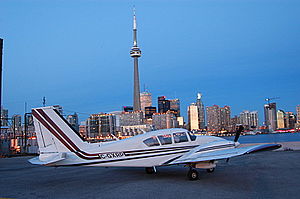Piper PA-23
| PA-23 Apache/Aztec | |
|---|---|
 |
|
| PA-23 Aztec in Toronto, Ontario | |
| Role | Twin-engined light piston utility |
| Manufacturer | Piper Aircraft |
| First flight | 2 March 1952 |
| Introduction | 1954 |
| Produced | 1952–1981 |
| Number built | 6,976 |
The Piper PA-23, named Apache and later Aztec, is a four-to-six-seat twin-engined light aircraft aimed at the general aviation market that also saw service with the United States Navy and other countries' military forces in small numbers. Originally designed in the 1950s by the Stinson Aircraft Company, the Apache and its more powerful development the Aztec were manufactured from the 1950s to the 1980s by Piper Aircraft in the United States.
The PA-23 was the first twin-engined Piper aircraft and was developed from a proposed "Twin Stinson" design, inherited when Piper bought the Stinson Division of the Consolidated Vultee Aircraft Corporation. The prototype PA-23 was a four-seat low-wing all-metal monoplane with a twin tail, powered by two 125 hp Lycoming O-290-D piston engines; it first flew on 2 March 1952. The aircraft performed badly and it was redesigned with a single vertical stabilizer and an all-metal rear fuselage and more powerful 150 hp Lycoming O-320-A engines. Two new prototypes of the redesigned aircraft, now named Apache, were built in 1953 and entered production in 1954; 1,231 were built. In 1958 the Apache 160 was produced by upgrading the engines to 160 hp (119 kW); 816 were built before being superseded in 1962 by the Apache 235. With a 1962 price of $45,000, the Apache 235 was a derivative of the Aztec, fitted with 235 hp (175 kW) versions of the engines used on the Aztec and swept tail surfaces (119 built).
In 1958 an upgraded version with 250 hp (186 kW) Lycoming O-540 engines and a swept vertical tail was produced as the PA-23-250 and was named Aztec. These first models came in a five-seat configuration which became available in 1959. In 1961 a longer nosed variant, the Aztec B, entered production. The later models of the Aztec were equipped with IO-540 fuel-injected engines and six-seat capacity, and continued in production until 1982. There were also turbocharged versions of the later models, which were able to fly at higher altitudes.
...
Wikipedia
